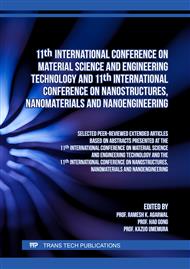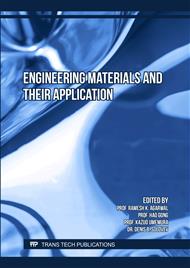[1]
R. N. M. Delda, R. B. Basuel, R. P. Hacla, D. W. C. Martinez, J.-J. Cabibihan, J. R. C. Dizon, 3D Printing Polymeric Materials for Robots with Embedded Systems, Technologies. (2021) 1–26.
DOI: 10.3390/technologies9040082
Google Scholar
[2]
G. S. Robles, R. N. M. Delda, R. Lui, B. Rosario, M. T. Espino, J. R. C. Dizon, Dimensional Accuracy of 3D - Printed Acrylonitrile Butadiene Styrene: Effect of Size , Layer Thickness and Infill Density. 913 (2022) 17–25.
DOI: 10.4028/p-nxviqm
Google Scholar
[3]
R. N. M. Delda, B. J. Tuazon, J. R. C. Dizon, Assessment of Interfacial Adhesion of Adhesively Bonded 3D-Printed Thermoplastics, Mater. Sci. Forum. 1005 (2020) 157–165.
DOI: 10.4028/www.scientific.net/msf.1005.157
Google Scholar
[4]
J. R. Diego, D. W. C. Martinez, G. S. Robles, J. R. C. Dizon, Development of Smartphone-Controlled Hand and Arm Exoskeleton for Persons with Disability," Open Eng., 11,1 (2021) 161–170.
DOI: 10.1515/eng-2021-0016
Google Scholar
[5]
J. R. C. Dizon, J. L. B. Crisostomo, 3D Printing Applications in Agriculture, Food Processing, and Environmental Protection and Monitoring, Key Eng. Mater. 913 (2022) 17–25.
Google Scholar
[6]
R. C. Advincula et al., Additive Manufacturing for COVID-19: Devices, Materials, Prospects and Challenges, MRS Commun. (2020) 1–15.
DOI: 10.1557/mrc.2020.57
Google Scholar
[7]
L. D. Tijing, J. R. C. Dizon, I. Ibrahim, A. R. N. Nisay, H. K. Shon, R. C. Advincula, 3D printing for membrane separation, desalination and water treatment, Appl. Mater. Today. 18 (2020).
DOI: 10.1016/j.apmt.2019.100486
Google Scholar
[8]
A. H. Espera, J. R. C. Dizon, Q. Chen, R. C. Advincula, "3D-printing and advanced manufacturing for electronics, Prog. Addit. Manuf., . 4 (2019) 245-267.
DOI: 10.1007/s40964-019-00077-7
Google Scholar
[9]
B. J. Tuazon, M. T. Espino, J. R. C. Dizon, Investigation on the Effects of Acetone Vapor-Polishing to Fracture Behavior of ABS Printed Materials at Different Operating Temperature, Materials Science Forum. 1005 (2020) 141–149.
DOI: 10.4028/www.scientific.net/msf.1005.141
Google Scholar
[10]
L. D. Tijing, J. R. C. Dizon, G. G. Cruz Jr., 3D-Printed Absorbers for Solar-Driven Interfacial Water Evaporation: A Mini-Review, Adv. Sustain. Sci. Eng. Technol. 3, 1 (2021) 0210103.
DOI: 10.26877/asset.v3i1.8367
Google Scholar
[11]
V. Hughes, I. Tabiai, K. Chizari, D. Therriault, 3D Printable Conductive Nanocomposites of PLA and Multi-Walled Carbon Nanotubes, Mater. Matter-Aldrich Chem. Co.11(2016), 61–63.
Google Scholar
[12]
S. Dul, L. Fambri, A. Pegoretti, Development of new nanocomposites for 3D printing applications. In Woodhead Publishing Series in Composites Science and Engineering, Structure and Properties of Additive Manufactured Polymer Components, Woodhead Publishing, Elsevier Inc., 2020.
DOI: 10.1016/b978-0-12-819535-2.00002-8
Google Scholar
[13]
S. Coiai, E. Passaglia, A. Pucci, G. Ruggeri, Nanocomposites based on thermoplastic polymers and functional nanofiller for sensor applications, Materials (Basel). 8, 6 (2015) 3377–3427.
DOI: 10.3390/ma8063377
Google Scholar
[14]
T. A. Campbell, O. S. Ivanova, 3D printing of multifunctional nanocomposites, Nano Today. 8, 2 (2013) 119–120.
DOI: 10.1016/j.nantod.2012.12.002
Google Scholar
[15]
A. D. Valino, J. R. C. Dizon, A. H. Espera, Q. Chen, J. Messman, R. C. Advincula, Advances in 3D printing of thermoplastic polymer composites and nanocomposites, Prog. Polym. Sci. 98 (2019).
DOI: 10.1016/j.progpolymsci.2019.101162
Google Scholar
[16]
G. Mago, S. C. Jana, S. S. Ray, T. McNally, Polymer nanocomposite processing, characterization, and applications 2012, J. Nanomater. 2012 (2012).
DOI: 10.1155/2012/924849
Google Scholar
[17]
B. Wang, Z. Zhang, Z. Pei, J. Qiu, S. Wang, Current progress on the 3D printing of thermosets, Adv. Compos. Hybrid Mater., 3, 4, (2020) 462–472.
DOI: 10.1007/s42114-020-00183-z
Google Scholar
[18]
J. Bhadra, A. Alkareem, N. Al-Thani, A review of advances in the preparation and application of polyaniline based thermoset blends and composites, J. Polym. Res. 27, 5 (2020).
DOI: 10.1007/s10965-020-02052-1
Google Scholar
[19]
A. K. T. Lau, D. Bhattacharyya, C. H. Y. Ling, Nanocomposites for engineering applications, J. Nanomater. 2009 (2009) 140586, 2009.
DOI: 10.1155/2009/140586
Google Scholar
[20]
N. S. Hmeidat, J. W. Kemp, B. G. Compton, High-strength epoxy nanocomposites for 3D printing, Compos. Sci. Technol. 160 (2018) 9–20.
DOI: 10.1016/j.compscitech.2018.03.008
Google Scholar
[21]
J. Z. Manapat, Q. Chen, P. Ye, R. C. Advincula, 3D Printing of Polymer Nanocomposites via Stereolithography, Macromol. Mater. Eng. 302, 9 (2017) 1–13, 2017.
DOI: 10.1002/mame.201600553
Google Scholar
[22]
M. Sajjad et al., Study of the effect of the concentration, size and surface chemistry of zirconia and silica nanoparticle fillers within an epoxy resin on the bulk properties of the resulting nanocomposites, Polym. Int. 61, 2 (2012) 274–285.
DOI: 10.1002/pi.3183
Google Scholar
[23]
Necati Ataberk, The effect of Cu nanoparticle adding on to epoxy-based adhesive and adhesion properties, Sci. Rep. 10, 1 (2020) 1–11.
DOI: 10.1038/s41598-020-68162-4
Google Scholar
[24]
F. Bensadoun, N. Kchit, C. Billotte, F. Trochu, E. Ruiz, A comparative study of dispersion techniques for nanocomposite made with nanoclays and an unsaturated polyester resin, J. Nanomater. 2011 (2011).
DOI: 10.1155/2011/406087
Google Scholar
[25]
Q. Chen, J. D. Mangadlao, J. Wallat, A. De Leon, J. K. Pokorski, R. C. Advincula, 3D printing biocompatible polyurethane/poly(lactic acid)/graphene oxide nanocomposites: Anisotropic properties, ACS Appl. Mater. Interfaces. 9,4, (2017) 4015–4023.
DOI: 10.1021/acsami.6b11793
Google Scholar
[26]
K. Müller et al., "Review on the processing and properties of polymer nanocomposites and nanocoatings and their applications in the packaging, automotive and solar energy fields," Nanomaterials. 7, 4 (2017).
DOI: 10.3390/nano7040074
Google Scholar
[27]
J. R. C. Dizon, Q. Chen, A. D. Valino, R. C. Advincula, Thermo-mechanical and swelling properties of three-dimensional-printed poly (ethylene glycol) diacrylate/silica nanocomposites, MRS Commun. 9, 1, (2019) 209–217.
DOI: 10.1557/mrc.2018.188
Google Scholar
[28]
M. Linec and B. Mušič, The effects of silica-based fillers on the properties of epoxy molding compounds, Materials (Basel).12, 11, (2019) 1–11.
DOI: 10.3390/ma12111811
Google Scholar
[29]
J. R. C. Dizon, C. C. L. Gache, H. M. S. Cascolan, L. T. Cancino, R. C. Advincula, Post-processing of 3D-Printed Polymers, Technologies, 9,3 (2021).
DOI: 10.3390/technologies9030061
Google Scholar
[30]
G. S. Robles, R. N. M. Delda, R. L. B. Del Rosario, M. T. Espino, J. R. C. Dizon, Dimensional Accuracy of 3D - Printed Acrylonitrile Butadiene Styrene: Effect of Size, Layer Thickness, and Infill Density, 913 (2022), 17-25.
DOI: 10.4028/p-nxviqm
Google Scholar
[31]
J. R. C. Dizon, A. H. Espera, Q. Chen, R. C. Advincula, Mechanical Characterization of 3D-printed Polymers, 20 (2018) 44-67.
DOI: 10.1016/j.addma.2017.12.002
Google Scholar



